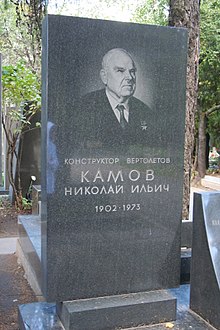Nikolai Ilyich Kamov

Nikolay Kamov (also Kamov , Russian Николай Ильич Камов , scientific. Transliteration Nikolai Kamov Il'ič * 1. jul. / 14. September 1902 greg. In Irkutsk ; † 24. November 1973) was the chief designer of him named Soviet / Russian design bureau Kamov , which specializes in the development of helicopters .
Life
Nikolai Kamov was the son of a teacher. In 1918 he began to study rail vehicle construction at the Technological Institute in Tomsk , which he completed in 1923 with an engineering degree. Since he had decided to design aircraft during his studies, he took a job as a locksmith in the Junkers branch in Fili near Moscow. In addition, he studied aerodynamics and aircraft construction on his own. Soon he moved to the maintenance department of the airline Dobroljot . In 1928 he was accepted into the "Department for Seaplane Experimental Construction " ( OMOS ), which worked on the twin-engine torpedo flying boat TOM-1 under the direction of Dmitri Grigorowitsch . In the group also worked well-known designers such as Sergei Koroljow , Michail Gurewitsch , Georgi Beriev , Vadim Schawrow and Igor Tschetwerikow . After Grigorowitsch's dismissal in 1928, the French Paul E. Richard took over the group.
Along with Nikolai Skrischinski designed Kamov 1929 the first Soviet autogyro , the KASKR . After testing it, he devoted himself entirely to the construction of rotary wing aircraft and in 1932 joined the “Office for Special Constructions” ( BOK ), where he took over the management of the gyroplane department. In addition to a few prototypes, the small-scale ZAGI A-7 gyroplane was built there in 1934 .
In 1944 he developed his first helicopter, the Ka-8 . For the first time, this exhibited the peculiarity of all of the following Kamow helicopters: They have two coaxial , counter-rotating rotors , which make torque compensation at the rear unnecessary, reduce the risk of injury to maintenance personnel or bystanders, avoid the loss of power when driving the tail rotor, and a smaller number of critical components exhibit. In the following years Kamow constructed other types, including a. the Ka-10 , Ka-15 , Ka-18 , Ka-22 , Ka-25 and Ka-26 .
Nikolai Kamow died on November 24, 1973. The Kamow company still exists today.
literature
- Wilfried Copenhagen : The helicopters of Nikolai Ilyich Kamow . In: Flieger Jahrbuch 1984 . Transpress, Berlin 1984.
Web links
- History of the Kamow design office ( Memento from February 6, 2006 in the Internet Archive )
- History of Kamow at helis.com (English)
| personal data | |
|---|---|
| SURNAME | Kamov, Nikolai Ilyich |
| ALTERNATIVE NAMES | Камов, Николай Ильич (Russian); Kamov, Nikolai Ilyich |
| BRIEF DESCRIPTION | soviet engineer |
| DATE OF BIRTH | September 14, 1902 |
| PLACE OF BIRTH | Irkutsk |
| DATE OF DEATH | November 24, 1973 |